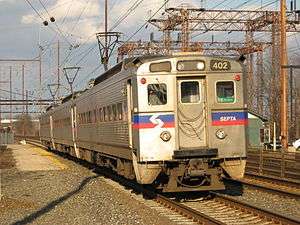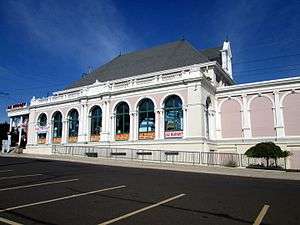Trenton Line (SEPTA)
| Trenton Line | |
|---|---|
 Train #4656 pulls into the Cornwells Heights station. | |
| Overview | |
| Type | Commuter rail |
| System | SEPTA Regional Rail |
| Status | Operating |
| Termini |
Trenton Transit Center Temple University |
| Stations | 15 |
| Daily ridership | 12,263[1]:94 |
| Website | septa.org |
| Operation | |
| Operator(s) | SEPTA |
| Technical | |
| Track gauge | 4 ft 8 1⁄2 in (1,435 mm) standard gauge |
| Electrification | Catenary |
The Trenton Line is a route of the SEPTA Regional Rail (commuter rail) system. The route serves the northeastern suburbs of Philadelphia, Pennsylvania with service in Bucks County along the Delaware River to Trenton, New Jersey.
Route
Trenton Line trains make local stops along Amtrak's Northeast Corridor between Philadelphia and Trenton, NJ. The section of Northeast Corridor the Trenton Line uses is a 4-track railroad, from 30th Street Station via the Philadelphia Zoo (without stopping there), to North Philadelphia, before running parallel to I-95 and then US 13 for several miles. It crosses the Delaware River at Trenton, New Jersey before making its final stop at Trenton Transit Center, which is also served by Amtrak and New Jersey Transit trains.
History
Electrified service between Philadelphia and Trenton began on June 29, 1930.
Between 1984–2010 the route was designated R7 Trenton as part of SEPTA's diametrical reorganization of its lines. Trenton Line trains operated through the city center to the Chestnut Hill East Line on the ex-Reading side of the system.[2]The R-number naming system was dropped on July 25, 2010.[3]
The Trenton line usually has two push-pull electric-locomotive-hauled trains on the morning express runs and two on the evening express runs. Each train is usually made up of 6 coach trailers made by Bombardier with AEM-7 or ALP-44 locomotives hauling them.
SEPTA activated positive train control on the Trenton Line on May 1, 2017.[4]
Stations
The Trenton Line includes the following stations north of the Center City Commuter Connection; stations indicated with gray background are closed. All stations within the Philadelphia city limits have a ticket office for purchasing ticket(s) to ride the Trenton line. Many stations outside the city limits have a ticket office as well, however they have shorter hours (most outside the city limits are closed on weekends) and fewer amenities than the ticket offices inside the stations within Philadelphia.
| Zone [5] |
Station[5] | Miles (km) from Center City |
Date opened |
Date closed |
Connections / notes[5] |
|---|---|---|---|---|---|
| C | Zoological Garden | 1.9 miles (3.1 km) | 1874 | November 24, 1901[6] | Station served the Philadelphia Zoo. |
| Engleside | 2.8 miles (4.5 km) | April 5, 1903[7] | Engelside was closed as part of the discontinuance of four stations on April 5, 1903.[7] | ||
| Ridge Avenue | 3.2 miles (5.1 km) | April 5, 1903[7] | Ridge Avenue was closed as part of the discontinuance of four stations on April 5, 1903.[7] | ||
| 22nd Street | 3.9 miles (6.3 km) | ||||
| 1 | North Philadelphia | 4.5 miles (7.2 km) | Amtrak: Keystone Service, Northeast Regional SEPTA: Chestnut Hill West Line, Broad Street Line, | ||
| 11th Street | |||||
| North Penn Junction | |||||
| Harrowgate | |||||
| Frankford Junction | October 4, 1992[8] | Frankford Junction was one of four stations discontinued on October 4, 1992.[8] | |||
| Frankford | 1990 | ||||
| 2 | Bridesburg | 9.3 miles (15.0 km) | SEPTA: | ||
| Fitler | |||||
| Wissinoming | 10.1 miles (16.3 km) | November 9, 2003[9] | SEPTA discontinued service to Wissinoming due to poor ridership.[9] | ||
| Tacony | 11.2 miles (18.0 km) | ||||
| Holmesburg Junction | 12.2 miles (19.6 km) | SEPTA: | |||
| 3 | Liddonfield | ||||
| Pierson's Station | |||||
| Torresdale | 14.8 miles (23.8 km) | SEPTA: | |||
| Philadelphia city line | |||||
| Andalusia | October 4, 1992[8] | Andalusia was one of four stations discontinued on October 4, 1992.[8] | |||
| Cornwells Heights | 16.9 miles (27.2 km) | Amtrak: Keystone Service, Northeast Regional SEPTA: | |||
| Eddington | 18.2 miles (29.3 km) | SEPTA: | |||
| Croydon | 19.9 miles (32.0 km) | SEPTA: | |||
| 4 | Bristol | 22.7 miles (36.5 km) | SEPTA: Bucks County TMA: | ||
| Edgely | 1956[10] | The railroad razed the depot at Edgely on January 16, 1957.[10] | |||
| Levittown | 26.0 miles (41.8 km) | April 26, 1953[11] | SEPTA: | ||
| Tullytown | |||||
| Morrisville | October 25, 1969[12] | ||||
| Delaware River; Pennsylvania–New Jersey state line | |||||
| NJ | Trenton Transit Center |
32.5 miles (52.3 km) | 1863 | ||
Ridership
Between FY 2008–FY 2014 yearly ridership on the Trenton Line has ranged from 3.1–3.5 million.[1]:94[13][14][15][16][17][18]
Notes
References
- 1 2 "Fiscal Year 2016 Annual Service Plan" (PDF). SEPTA. June 2015. Retrieved August 13, 2016.
- ↑ Vuchic, Vukan; Kikuchi, Shinya (1984). General Operations Plan for the SEPTA Regional High Speed System. Philadelphia: SEPTA. pp. 2–8.
- ↑ Lustig, David (November 2010). "SEPTA makeover". Trains Magazine. Kalmbach Publishing: 26.
- ↑ "Positive Train Control Update". SEPTA. May 1, 2017. Retrieved May 17, 2017.
- 1 2 3 "Trenton Line Timetable" (PDF). Philadelphia, Pennsylvania: Southeastern Pennsylvania Transportation Authority. September 10, 2017. Retrieved October 17, 2017.
- ↑ Baer, Christopher T. (April 2015). "A General Chronology of the Successors of the Pennsylvania Railroad Company and Their Historical Context: 1901" (PDF). Pennsylvania Railroad Technical Historical Society. Retrieved October 17, 2017.
- 1 2 3 4 "Discontinuing All Stops of Trains at Paschal, South Street, Engelside and Ridge Avenue". The Philadelphia Inquirer. Philadelphia, Pennsylvania. April 3, 1903. p. 2. Retrieved October 17, 2017 – via Newspapers.com.

- 1 2 3 4 "New Rail Schedules Set". The Philadelphia Inquirer. Philadelphia, Pennsylvania. October 2, 1992. p. 36. Retrieved October 17, 2017 – via Newspapers.com.

- 1 2 "SEPTA Regional Rail Schedules Change Sunday" (Press release). PR Newswire Association LLC. November 5, 2003. Retrieved October 17, 2017.
- 1 2 "Landmark Ruled Out". The Bristol Daily Courier. Bristol, Pennsylvania. January 17, 1957. p. 7. Retrieved October 17, 2017 – via Newspapers.com.

- ↑ "Levittown New Train Schedule Effective April 27" (The Bristol Daily Courier). Bristol, Pennsylvania. April 15, 1953. Retrieved December 20, 2015 – via Newspapers.com.

- ↑ Baer, Christopher T. (April 2015). "A General Chronology of the Successors of the Pennsylvania Railroad Company and Their Historical Context: 1969" (PDF). Pennsylvania Railroad Technical Historical Society. Retrieved October 17, 2017.
- ↑ "Fiscal Year 2015 Annual Service Plan" (PDF). SEPTA. May 2014. p. 60. Retrieved August 13, 2016.
- ↑ "Fiscal Year 2014 Annual Service Plan" (PDF). SEPTA. May 2013. p. 44. Retrieved August 13, 2016.
- ↑ "Fiscal Year 2013 Annual Service Plan" (PDF). SEPTA. May 2012. p. 55. Retrieved August 13, 2016.
- ↑ "Fiscal Year 2012 Annual Service Plan" (PDF). SEPTA. July 2011. p. 94. Retrieved August 13, 2016.
- ↑ "Fiscal Year 2011 Annual Service Plan" (PDF). SEPTA. June 2010. p. 70. Retrieved August 13, 2016.
- ↑ "FY 2010 Annual Service Plan" (PDF). SEPTA. June 2009. p. 63. Retrieved August 13, 2016.

